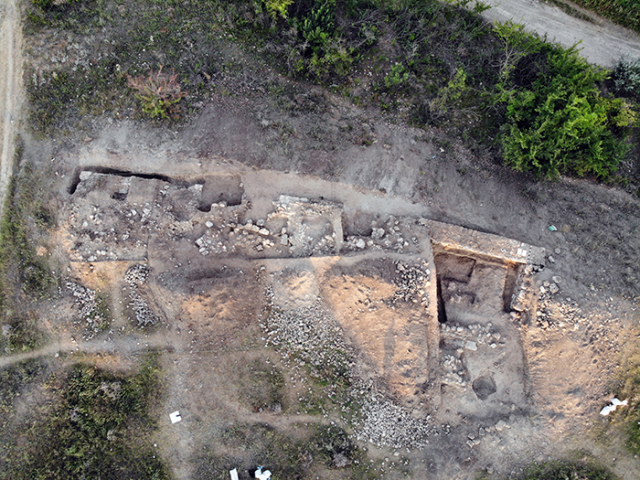Near Tiahynka countryside (Kherson oblast, Berislav rayon), participants of the Southern Medieval Expedition launched by the Institute of Archeology under the National Academy of Sciences of Ukraine received new, extremely important results while studying the national monument - the Fortress of Tiahynka.
According to the Institute of Archeology (the National Academy of Sciences of Ukraine), due to its territory location in the Lower Dnieper region, the fortress is of considerable interest for studying little-known pages of the Middle Ages, namely the history of the Lithuanian Ruthenian statehood, the Golden Horde, the Crimean Khanate, the commercial activities of the Italian cities of Genoa and Venice by the Black Sea, Ottoman Empire and Ukrainian Cossacks’ contacts.
The excavations confirmed the presence of one of the largest Golden Horde cities of the Lower Dnieper region in the second half of the 13th - mid 14th century. Researchers proved that Vytautas, the ruler of the Great Duchy of Lithuania and Rus’, had built the fortress and customs in the late XIV century that were functioning in the XV century. The bathymetric explorations of the adjacent zone of Tiahynka and Dnipro Rivers revealed the places of river crossings and a dock.
During topographic and aerial photographic researches, archaeologists established the area of the settlement and the fortress, the planning and the defense system that are genetically related to the traditions of Kyivan Rus’ and represent a general European type that is typical to the territories from the Baltic region to the Northern Black Sea.
Scientists consider the found things of Lithuanian material culture extremely important - overlays on leather wallets, crossbow bolts, and jewelry elements confirm the presence of immigrants from Lithuania in the fortress.
In general, the archeological collection of artifacts of Lithuanian origin, Byzantine and Crimean sgraffito ceramics, Golden Horde glazed ceramics, Polish and Golden Horde coins (sometimes with Genoese counter-marking), armaments (crossbow bolts, arrowheads and stone balls) let us remodel the syncretic culture of Southern Ukraine as well as the international relations of those times.
Due to archaeological research, the explorers managed to trace the important features of the Grand Duchy of Lithuania and Rus’ southern border, which included the Kyiv principality - one of the main successors to the Kyivan Rus’ heritage. The historic mission of the Grand Duke Vytautas’ fortification strategy and practice of protecting the borders of Ukrainian lands, contributed to the formation of new relations in the multiethnic environment of the South, and was of fundamental importance for the emergence of conditions that led to the formation of a new state of Ukrainian society - the Cossacks. The location of Tiahynka fortress near the southern border with the Golden Horde made it possible to control the water and land trade routes that stretched from the Southeast to the West - to Kyiv, Lviv, Krakow and farther.
Discoveries made during the field season 2018 testifies the necessity to continue archaeological researches, to conserve southern border monument of the Grand Duchy of Lithuania and Rus’ and to make a museum from it, as well as to study the culture of southern Ukraine, its relations and economic development during the federal state existence.
The preservation of the fortress bulwark requires conserving, restoring and turning the fortifications into the museum – so it would be used in order to develop the tourist activities, to promote the knowledge about the historical past. In addition, according to archaeologists, it is necessary to resolve the issue concerning the protection of the fortress remains and to create the museum "Tiahynka Fortress" as the basis of the future historical and archaeological reserve.
Given the importance of the fortress of Tiahynka in the history of Ukraine and Lithuania, the monument acquires not only national but also international importance. This is a cross point of the historical paths of civilizations of the Turkic peoples and the nations of the Baltic States and Ukraine.
Archaeological research was carried out thanks to charitable assistance under the project “Protecting the Historical Heritage of Ukraine and Lithuania in the Kherson Region”, funded by the Development Cooperation and Democracy Support Program of the Ministry of Foreign Affairs of the Republic of Lithuania in accordance with the scientific cooperation agreement with the Institute of Archeology of the National Academy of Sciences of Ukraine ( dated September 1, 2017) and the Agreement on the implementation of the above-mentioned project No. P2018 – VB-UK-58 between the Central Project Management Agency and Kherson city public organisation "Cultural Centre Ukraine-Lithuania".
Meanwhile, the Uryadovyi Courier cites the words of the expedition leader, the leading researcher of the Old Russian and Medieval Archeology Department under the Institute of Archeology of the National Academy of Sciences of Ukraine, the chairman of the Historical and Cultural Association “Ukraine - Turkey” Svetlana Belyayeva, convinced that there was a Tatar city in the excavation site:
- We believe that the fortress did not emerge from scratch. Previously here was a Tatar city, as evidenced by the found artifacts of these cultures. Here was the border of the Grand Duchy of Lithuania where crossing customs were situated ... This year we found a lot of Tatar coins with tamga, which evidenced the developed trading activities. A Genoese stamp exists on many coins, Kafa chasing. Last year, we found coins dated to the end of the XIV century. - the beginning of the XV century. We have not given yet the coins, found this year, to numismatists, but we think that they belong to approximately the same period.




